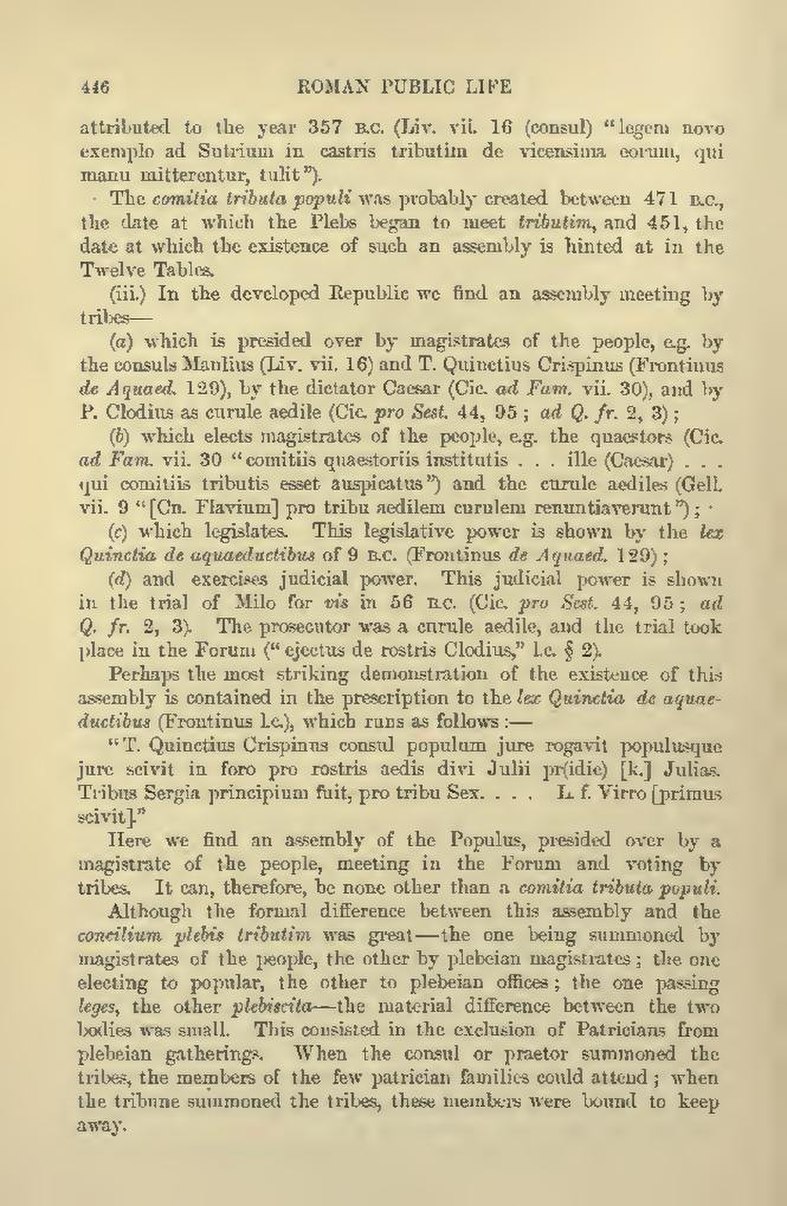attributed to the year 357 B.C. (Liv. vii. 16 (consul) "legem novo exemplo ad Sutrium in castris tributim de vicensima eorum, qui manu mitterentur, tulit").
The comitia tributa populi was probably created between 471 B.C., the date at which the Plebs began to meet tributim, and 451, the date at which the existence of such an assembly is hinted at in the Twelve Tables.
(iii.) In the developed Republic we find an assembly meeting by tribes—
(a) which is presided over by magistrates of the people, e.g. by the consuls Manlius (Liv. vii. 16) and T. Quinctius Crispinus (Frontinus de Aquaed. 129), by the dictator Caesar (Cic. ad Fam. vii. 30), and by P. Clodius as curule aedile (Cic. pro Sest. 44, 95; ad Q. fr. 2, 3);
(b) which elects magistrates of the people, e.g. the quaestors (Cic. ad Fam. vii. 30 "comitiis quaestoriis institutis . . . ille (Caesar) . . . qui comitiis tributis esset auspicatus") and the curule aediles (Gell. vii. 9 "[Cn. Flavium] pro tribu aedilem curulem renuntiaverunt");
(c) which legislates. This legislative power is shown by the lex Quinctia de aquaeductibus of 9 B.C. (Frontinus de Aquaed. 129);
(d) and exercises judicial power. This judicial power is shown in the trial of Milo for vis in 56 B.C. (Cic. pro Sest. 44, 95; ad Q. fr. 2, 3). The prosecutor was a curule aedile, and the trial took place in the Forum ("ejectus de rostris Clodius," l.c. § 2).
Perhaps the most striking demonstration of the existence of this assembly is contained in the prescription to the lex Quinctia de aquaeductibus (Frontinus l.c.), which runs as follows:—
"T. Quinctius Crispinus consul populum jure rogavit populusque jure scivit in foro pro rostris aedis divi Julii pr(idie) ḳ Julias. Tribus Sergia principium fuit, pro tribu Sex. . . . L.f. Virro [primus scivit]."
Here we find an assembly of the Populus, presided over by a magistrate of the people, meeting in the Forum and voting by tribes. It can, therefore, be none other than a comitia tributa populi.
Although the formal difference between this assembly and the concilium plebis tributim was great—the one being summoned by magistrates of the people, the other by plebeian magistrates; the one electing to popular, the other to plebeian offices; the one passing leges, the other plebiscita—the material difference between the two bodies was small. This consisted in the exclusion of Patricians from plebeian gatherings. When the consul or praetor summoned the tribes, the members of the few patrician families could attend; when the tribune summoned the tribes, these members were bound to keep away.
